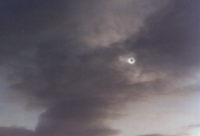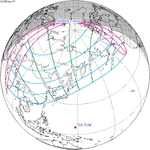Solar eclipse of February 26, 1979
| Solar eclipse of February 26, 1979 | |
|---|---|
 Totality as seen from Brandon, Manitoba | |
 Map | |
| Type of eclipse | |
| Nature | Total |
| Gamma | 0.8981 |
| Magnitude | 1.0391 |
| Maximum eclipse | |
| Duration | 169 sec (2 m 49 s) |
| Coordinates | 52°06′N 94°30′W / 52.1°N 94.5°W |
| Max. width of band | 298 km (185 mi) |
| Times (UTC) | |
| Greatest eclipse | 16:55:06 |
| References | |
| Saros | 120 (59 of 71) |
| Catalog # (SE5000) | 9462 |
A total solar eclipse occurred in North America on February 26, 1979.
A solar eclipse is an astronomical phenomenon that occurs when the Moon passes between Earth and the Sun, thereby totally or partly obscuring the image of the Sun for a viewer on Earth. A total solar eclipse occurs when the Moon's apparent diameter is larger than the Sun's, blocking all direct sunlight, turning day into darkness. Totality occurs in a narrow path across Earth's surface, with the partial solar eclipse visible over a surrounding region thousands of kilometres wide. Occurring only 18 hours and 35 minutes after perigee (Perigee on February 25, 1979 at 22:19 UTC), the Moon's apparent diameter was larger.
The central shadow of the moon passed through the American states of Washington, Oregon, Idaho, Montana (where totality covered almost the entire state), and North Dakota, the Canadian provinces Saskatchewan, Manitoba, Ontario, and Quebec, the Northwest Territories of Canada (the portion that is now Nunavut), and Greenland.
Visibility[]

Many visitors traveled to the Pacific Northwest to view the Monday morning eclipse,[1] as it was the last chance to view a total solar eclipse in the contiguous United States for 38 years, 5 months, 26 days. The next opportunity was on August 21, 2017.
Although the path of totality passed through Portland shortly after sunrise (maximum at 8:14 am PST),[2] it was not directly observable due to overcast skies in northwestern Oregon.[3][4]
About a half hour later, the path of totality was in Manitoba and passed through cloudless Winnipeg in the late morning, maximum was at 10:48 am CST.[5] The greatest eclipse occurred seven minutes later at 10:55 am CST.
In literature[]
Writer Annie Dillard viewed the eclipse from the Yakima Valley, in central Washington State. She described her impressions of the eclipse in an essay, "Total Eclipse," first published in the magazine Antaeus and then in her collection, Teaching a Stone to Talk (1982). It was later selected for inclusion in The Best American Essays of the [20th] Century (2000).[6] Dillard describes a nearly overwhelming emotional experience, as suggested in this quotation: "I pray you will never see anything more awful in the sky." Describing the reactions of other onlookers, she relates "I heard screams."
The 1979 eclipse was also referenced in the opening pages of Douglas Coupland's novel, Generation X.

Totality from Bozeman, Montana

Projected partial eclipse from Scenic, South Dakota
Related eclipses[]
A partial lunar eclipse occurred on March 13, 1979, 15 days later, visible over Africa, Europe and Asia. 177 days later after the total solar eclipse of February 26, 1979, occurred an annular solar eclipse on August 22, 1979. A total lunar eclipse followed on September 6, 1979. 355 days after the total solar eclipse of February 26, 1979, occurred a total solar eclipse on February 16, 1980.
Eclipses in 1979[]
- A total solar eclipse on Monday, 26 February 1979.
- A partial lunar eclipse on Tuesday, 13 March 1979.
- An annular solar eclipse on Wednesday, 22 August 1979.
- A total lunar eclipse on Thursday, 6 September 1979.
Solar eclipses of 1979–1982[]
This eclipse is a member of a semester series. An eclipse in a semester series of solar eclipses repeats approximately every 177 days and 4 hours (a semester) at alternating nodes of the Moon's orbit.[7] There were 8 solar eclipses between February 26, 1979 and July 20, 1982. Were there: February 26, 1979 (total solar eclipse, 0.8 days after perigee, 103.9%, 0.89811 gamma, saros 120), August 22, 1979 (small annular solar eclipse, 0.6 days before apogee, 93.3%, -0.96319 gamma, saros 125), February 16, 1980 (total solar eclipse, 1 day before perigee, 104.3%, 0.22244 gamma, saros 130), August 10, 1980 (large annular solar eclipse, 5 days before apogee, 97.3%, -0.19154 gamma, saros 135), February 4, 1981 (large annular solar eclipse, 4 days before perigee, 99.4%, -0.48375 gamma, saros 140), July 31, 1981 (total solar eclipse, 3.8 days after perigee, 102.6%, 0.57917 gamma, saros 145), January 25, 1982 (moderate partial solar eclipse, 4.7 days after apogee, 56.6%, -1.23110 gamma, saros 150) and July 20, 1982 (small partial solar eclipse, 0.9 days after perigee, 46.4%, 1.28859 gamma, saros 155).
| Solar eclipse series sets from 1979–1982 | ||||||
|---|---|---|---|---|---|---|
| Descending node | Ascending node | |||||
| Saros | Map | Gamma | Saros | Map | Gamma | |
| 120 |  1979 February 26 Total |
0.89811 | 125 |  1979 August 22 Annular |
-0.96319 | |
| 130 |  1980 February 16 Total |
0.22244 | 135 |  1980 August 10 Annular |
-0.19154 | |
| 140 |  1981 February 4 Annular |
-0.48375 | 145 |  1981 July 31 Total |
0.57917 | |
| 150 |  1982 January 25 Partial |
-1.23110 | 155 |  1982 July 20 Partial |
1.28859 | |
| Partial solar eclipses on June 21, 1982 and December 15, 1982 occur in the next lunar year eclipse set. | ||||||
Saros 120[]
This eclipse is a part of Saros cycle 120, repeating every 18 years, 11 days, containing 71 events. The series started with partial solar eclipse on May 27, 933 AD, and reached an annular eclipse on August 11, 1059. It was a hybrid event for 3 dates: May 8, 1510, through May 29, 1546, and total eclipses from June 8, 1564, through March 30, 2033. The series ends at member 71 as a partial eclipse on July 7, 2195. The longest duration of totality was 2 minutes, 50 seconds on March 9, 1997. All eclipses in this series occurs at the Moon’s descending node.
| Series members 55–65 occur between 1901 and 2100 | ||
|---|---|---|
| 55 | 56 | 57 |
 January 14, 1907 |
 January 24, 1925 |
 February 4, 1943 |
| 58 | 59 | 60 |
 February 15, 1961 |
 February 26, 1979 |
 March 9, 1997 |
| 61 | 62 | 63 |
 March 20, 2015 |
 March 30, 2033 |
 April 11, 2051 |
| 64 | 65 | |
 April 21, 2069 |
 May 2, 2087 | |
Metonic cycle[]
The metonic series repeats eclipses every 19 years (6939.69 days), lasting about 5 cycles. Eclipses occur in nearly the same calendar date. In addition, the octon subseries repeats 1/5 of that or every 3.8 years (1387.94 days). All eclipses in this table occur at the Moon's descending node.
| 21 events between July 22, 1971 and July 22, 2047 | ||||
|---|---|---|---|---|
| July 21–22 | May 9–11 | February 26–27 | December 14–15 | October 2–3 |
| 106 | 108 | 110 | 112 | 114 |
| July 21, 1952 | May 10, 1956 | February 26, 1960 | December 16, 1963 | October 3, 1967 |
| 116 | 118 | 120 | 122 | 124 |
 July 22, 1971 |
 May 11, 1975 |
 February 26, 1979 |
 December 15, 1982 |
 October 3, 1986 |
| 126 | 128 | 130 | 132 | 134 |
 July 22, 1990 |
 May 10, 1994 |
 February 26, 1998 |
 December 14, 2001 |
 October 3, 2005 |
| 136 | 138 | 140 | 142 | 144 |
 July 22, 2009 |
 May 10, 2013 |
 February 26, 2017 |
 December 14, 2020 |
 October 2, 2024 |
| 146 | 148 | 150 | 152 | 154 |
 July 22, 2028 |
 May 9, 2032 |
 February 27, 2036 |
 December 15, 2039 |
 October 3, 2043 |
| 156 | ||||
 July 22, 2047 | ||||
Notes[]
- ^ "Eclipse chased across Northwest". Daytona Beach Morning Journal. (Florida). (New York Times). February 27, 1979. p. 1A.
- ^ "Total Eclipse". Spokesman-Review. (Spokane, Washington). February 25, 1979. p. 6.
- ^ "Thick clouds hide eclipse from many". Eugene Register-Guard. (Florida). Associated Press. February 26, 1979. p. 1A.
- ^ "Sun gives a wink to Northwest U.S." Spokane Daily Chronicle. (Washington). Associated Press. February 26, 1979. p. 1.
- ^ Van, Jon (February 27, 1979). "Eclipse turns morning to night at 10:48 am". Chicago Tribune. p. 2, sec. 1.
- ^ Atwan, Robert (2001-10-10). Oates, Joyce Carol (ed.). The Best American Essays of the Century (Reprint ed.). Mariner Books. ISBN 9780618155873.
- ^ van Gent, R.H. "Solar- and Lunar-Eclipse Predictions from Antiquity to the Present". A Catalogue of Eclipse Cycles. Utrecht University. Retrieved 6 October 2018.
References[]
- Earth visibility chart and eclipse statistics Eclipse Predictions by Fred Espenak, NASA/GSFC
- eclipse.org.uk Total Eclipse of the Sun: 1979 February 26
- Predictions for the 1979 solar eclipse Royal Astronomical Society of Canada, Journal, vol. 72, June 1978, pp. 149–161 Fred Espenak
External links[]
Photos/observations:
- Eclipse Chaser's Journal: Part 1, My First Total Solar Eclipse: February 26. 1979, Jeffrey R. Charles
- http://nicmosis.as.arizona.edu:8000/ECLIPSE_WEB/ECLIPSE_79/ECLIPSE_79.html
- 1979 Solar Eclipse – ABC News Coverage Excerpts from an ABC News Special Report that aired at 11:00–11:29 a.m. EST on Monday, Feb. 26, 1979
- 1979 Total Solar Eclipse Report on CBS News with Walter Cronkite The February 26, 1979 total solar eclipse story as reported on the CBS Evening News with Walter Cronkite.
- Solar Eclipse Photo Gallery 1, 1970 – 1984 Fred Espenak
- Solar eclipse 1979, Manitoba, Canada
| Wikimedia Commons has media related to Solar eclipse of 1979 February 26. |
- Total solar eclipses
- 20th-century solar eclipses
- 1979 in science
- February 1979 events





